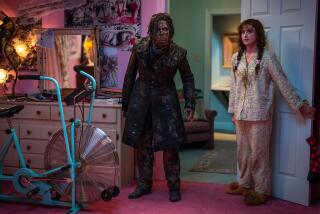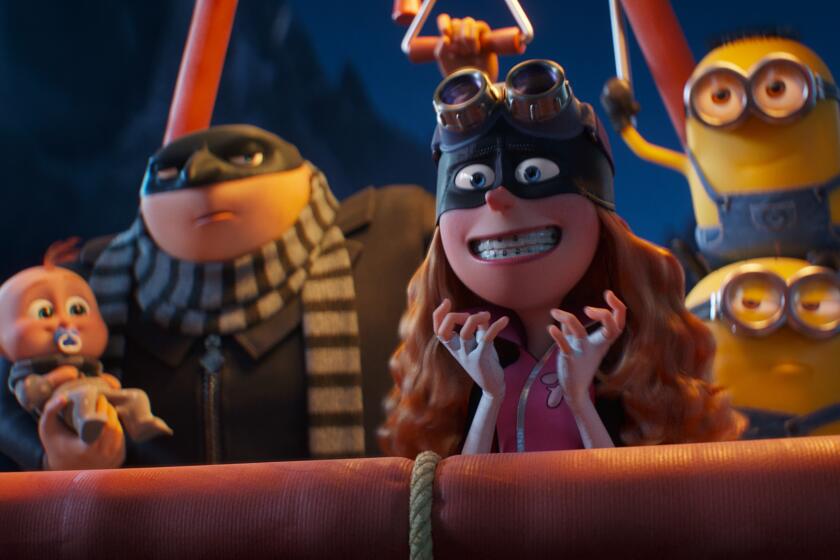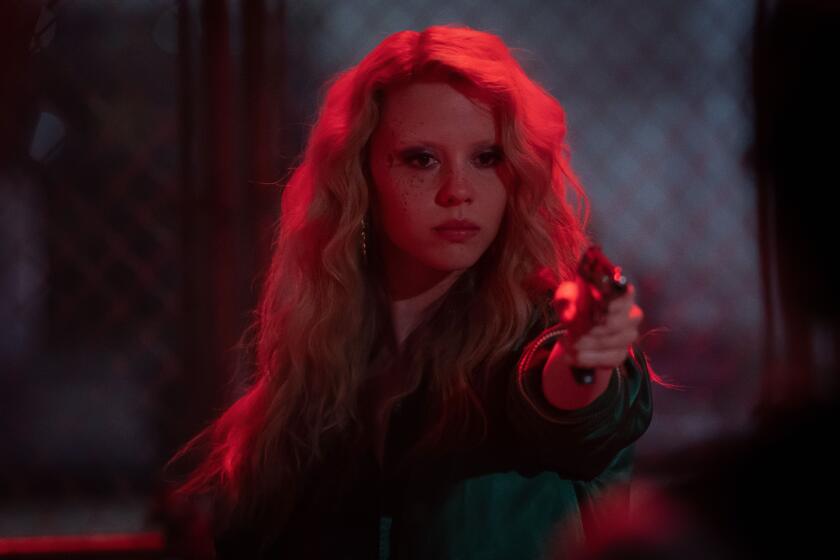Review: Robert Zemeckis’ psychodrama ‘Welcome to Marwen’ is muddled, misguided — and weirdly compelling
On April 8, 2000, a U.S. Navy veteran named Mark Hogancamp was savagely attacked and beaten by five men outside a bar in Kingston, N.Y. His injuries were severe — “every memory kicked out of my head,” he would later note — and he spent a year learning to walk and speak again. But while the assault cost him nearly everything, including his ability to draw, it couldn’t stifle his creative impulse, which become the basis for an intuitive and ingenious form of therapy.
An array of dollhouse-like buildings sprang up outside Hogancamp’s trailer home, a place he dubbed Marwencol, an imaginary Belgian town under attack by Nazis during World War II. He filled it with Barbie- and G.I. Joe-like dolls whose harrowing adventures — which Hogancamp choreographed and photographed with the precision of a stop-motion animator — held up a mirror to his own life-altering ordeal.
The striking beauty and wormy mystery of Hogancamp’s art were explored at length in Jeff Malmberg’s 2010 documentary, “Marwencol.” (The name is a portmanteau of Mark, Wendy and Colleen, the last two names significant women in Hogancamp’s life.) Consisting of interviews with Hogancamp and his friends, many of whom doubled as Marwencol residents, the documentary unraveled a strange, beguiling story of small-town bigotry and personal obsession. Being a chronicle of memory loss and fractured identity, it left more than a few questions about its subject unanswered.
You might wish they’d stayed that way. This week sees the arrival of “Welcome to Marwen,” a fictionalized Hollywood retelling starring Steve Carell as Hogancamp and directed by Robert Zemeckis. It’s a muddled, tortured miasma of a movie and also, inevitably, a fascinating one.
Set at the juncture of human drama and pop spectacle, like much of Zemeckis’ work, it takes an intimate story of human struggle and runs it through a noisy gantlet of up-to-the-minute visual effects. Where “Marwencol” tiptoed deftly through the minefield of its subject’s psyche, “Welcome to Marwen” barrels ahead with almost admirably clumsy conviction, triggering random eruptions of sentimentality and insight in its wake.
This may sound like an apt approach to this material, an honest attempt to fuse the darker revelations of Hogancamp’s story with the crowd-pleasing dictates of popular screen entertainment. Certainly it explains the casting of Carell, a likable comic actor who, like a more tamped-down Robin Williams, is very much in touch with his sentimental side. Keeping mostly to himself and poring over his dolls, this Mark emerges as a kind of sad-sack savant, an affable blend of shy naif and troubled genius.
And to its credit, “Welcome to Marwen” doesn’t attempt to over-explain Mark’s one-sixth-scaled imitation of life. Nor does it shy away from the weirder, more taboo aspects of his story. The opening sequence brings us directly into his land of miniature make-believe, where a fighter pilot named Capt. Hogie crash-lands near the town of Marwen (the “col” is still to come) and runs afoul of Nazi occupiers. They taunt him when they see that he is wearing women’s shoes, an early allusion to Mark’s own penchant for cross-dressing, hinting at the specific bigotry that motivated his attackers years earlier.
The plastic people of Marwen achieve sentience through performance-capture technology, a digital innovation of which Zemeckis has been an early adopter and fervent champion. But while it can get tiresome watching these dolls exchange wisecracks and gunfire, the effect is more tolerable than that of the self-enclosed fantasy worlds of “The Polar Express” and “Mars Needs Moms,” mainly because we’re meant to see these characters as ciphers and stand-ins. Zemeckis keeps both Marwen and Kingston in play, cutting between them to sometimes fluid, sometimes jarring effect. A certain incoherence, an inability to distinguish fantasy from reality, seems very much the point.
Capt. Hogie’s adventures follow a repetitive, literal-minded psychological pattern. Even after the Nazis have been vanquished, they return to abuse him again and again, much like Mark’s lingering trauma. A scheming witch named Deja Thoris (Diane Kruger) torments the captain at every step, her blue hair pointedly the same color as the pills to which Mark has become addicted. But Hogie prevails thanks to a small army of women who are both tough as nails and fabulously attired, thanks to their creator’s impeccable eye for wartime cosplay.
For a while it’s diverting to match these avatars with their real-life counterparts, some of whom pop up for a scene or two, like Mark’s caretaker (a Russian-accented Gwendoline Christie), his physical therapist (Janelle Monáe) and his favorite porn star (Leslie Zemeckis — yes, the director’s wife). More lasting impressions are made by Roberta (a lovely Merritt Wever, giving the movie’s best performance), who runs a local toy shop, and also by a new neighbor, Nicol (Leslie Mann), who captivates Mark and immediately enters his doll rotation.
Zemeckis, who wrote the script with Caroline Thompson, does everything he can to open up an interior story. He plants seeds of romantic anxiety and engineers a heavy-handed subplot involving Mark’s attackers, who face lengthy prison sentences. But most of his energy goes into the hectic scenes of gunplay, immolation and flagellation that preoccupy Marwen, orchestrated with all the enthusiasm of a child at play.
We are presumably meant to find that enthusiasm infectious, though I was distracted at how detached much of the action feels from its psychological underpinnings. Hogancamp’s still photographs, which were studied at length in “Marwencol” and have since earned him the attention of the New York art world, provided a more haunting glimpse into his trauma than Zemeckis’ virtuosic bag of tricks can manage.
This may well be deliberate. At a certain point it becomes clear that Zemeckis isn’t merely telling Mark Hogancamp’s story; he’s also telling his own. You might suspect as much when you see the Allied moving van unloading Nicol’s boxes, or when Capt. Hogie starts flying around in his own makeshift DeLorean. You might feel charmed by this movie’s implicit callbacks to the small-town Americana of “Forrest Gump” and also repelled by how openly it seems to leer at the women of Marwen and their Barbie-doll proportions; you half expect Angelina Jolie’s stiletto-heeled succubus from “Beowulf” to show up.
It’s not entirely clear what the director is trying to say with these self-conscious allusions: Perhaps, after his erratic recent career phase, dotted with failed experiments and a few undeserved flops (“The Walk,” “Allied”), he feels like something of an outsider artist himself. Or perhaps he’s acknowledging an idea that runs through his work as surely as it does through Hogancamp’s, namely that tinkering with toys can be a welcome escape from dealing with the messiness of everyday humanity.
In other words, this is personal filmmaking at its most perplexing, an act of empathy as well as narcissism, as Zemeckis seizes on one man’s art therapy and cranks out his own monumental self-reflection. You may be repelled, in the moment, by its oil-and-water mix of tortured sentimentality and creepy puppet play. You might also find it damnably hard to shake.
------------
<strong>‘Welcome to Marwen’</strong>
Rating: PG-13, for sequences of fantasy violence, some disturbing images, brief suggestive content, thematic material and language
Running time: 1 hour, 56 minutes
Playing: In general release
-------------
ALSO
Justin Chang’s best movies of 2018: ‘Burning’ and ‘First Reformed’ lead a year of mystery
Kenneth Turan’s best movies of 2018: ‘Black Panther’ and ‘Leave No Trace’ top a banner year
More to Read
Only good movies
Get the Indie Focus newsletter, Mark Olsen's weekly guide to the world of cinema.
You may occasionally receive promotional content from the Los Angeles Times.
![LOS ANGELES, CA - JUNE 17: [Cody Ma and Misha Sesar share a few dishes from their Persian Restaurant Azizam] on Monday, June 17, 2024 in Los Angeles, CA. (Ethan Benavidez / For The Times)](https://ca-times.brightspotcdn.com/dims4/default/7ffc7f6/2147483647/strip/true/crop/5110x3417+306+0/resize/320x214!/quality/75/?url=https%3A%2F%2Fcalifornia-times-brightspot.s3.amazonaws.com%2F79%2Fdc%2F4d29255545f5b9813315901692bc%2F1459972-fo-azizam-review20-eba.JPG)






